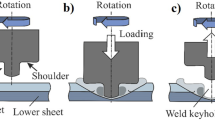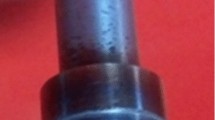Abstract
Amount of intermetallics formed at the weld interface in dissimilar friction stir welding may be reduced by use of suitable interlayer materials such as Zn. In the present investigation, mathematical models have been developed for prediction of tensile properties of dissimilar AA6061-T6 to pure Cu welds prepared by friction stir welding process with Zn interlayer. Experiments were planned as per Box–Behnken design of response surface methodology. Three-factor, three-level Box–Behnken design with 15 runs was employed. Three process parameters: tool rotation speed (710, 1000 and 1400 rpm), tool travel speed (28, 56 and 80 mm/min) and tool pin offset (+0.5, +1.0 and +1.5 mm towards AA6061-T6 sheet) were considered. Lacks of fit for the developed models were assessed using analysis of variance (ANOVA). Validities of the developed models were checked by conducting confirmation runs. Predicted and experimental results of confirmation runs were found in reasonable agreements. Microstructural characterization revealed typical microstructure composed of intercalation of base metals. It was observed by X-ray diffraction analysis that use of Zn interlayer coupled with tool offset of +1.0 and +1.5 resulted in elimination of intermetallics of Al–Cu system at the weld interface, improving dissimilar weld quality.

















Similar content being viewed by others
Abbreviations
- AISI:
-
American Iron and Steel Institute
- ANOVA:
-
analysis of variance
- AS:
-
advancing side
- ASTM:
-
American Society of Testing Materials
- DOE:
-
design of experiments
- FWHM:
-
full-width at half-maximum
- RS:
-
retreating side
- TMAZ:
-
thermo-mechanically affected zone
- TWI:
-
The Welding Institute
- UTS:
-
ultimate tensile strength
- XRD:
-
X-ray diffraction
- YS:
-
yield strength
References
Thomas W M, Nicholas E D, Needham J C, Murch M G, Templesmith P and Dawes C J 1991 Improvements to friction welding. G B Patent No. 9125978.8, UK
Dawes C and Thomas W 1995 Friction stir joining of aluminium alloys. TWI Bull. 6: 124
Mishra R S and Mahoney M W (Eds.) 2007 Friction stir welding and processing, 1st ed. Ohio, USA: ASM International, pp. 1–155
Okamura H and Aota K 2004 Joining of dissimilar materials with friction stir welding. Weld. Int. 18(11): 852–860
Li M and Zinkle S J 2012 Physical and mechanical properties of copper and copper alloys. In: Konings R J M (Ed.) Comprehensive nuclear materials, 1st ed. Amsterdam: Elsevier, vol. 4, pp. 667–690
Macwan A, Mirza F A, Bhole S D and Chen D L 2017 Similar and dissimilar ultrasonic spot welding of 5754 aluminum alloy for automotive applications. Mater. Sci. Forum 877: 561–568
Kah P, Shrestha M and Martikainen J 2014 Trends in joining dissimilar metals by welding. Appl. Mech. Mater. 440: 269–276
Muthu M F X and Jayabalan V 2015 Tool travel speed effects on the microstructure of friction stir welded aluminium–copper joints. J. Mater. Process. Technol. 217: 105–113
Xue P, Xiao B L, Ni D R and Ma Z Y 2010 Enhanced mechanical properties of friction stir welded dissimilar Al–Cu joint by intermetallic compounds. Mater. Sci. Eng. A 527: 5723–5727
Genevois C, Girard M, Huneau B, Sauvage X and Racineux G 2011 Interfacial reaction during friction stir welding of Al and Cu. Metall. Mater. Trans. A 42A: 2290–2295
Bisadi H, Tavakoli A, Sangsaraki M T and Sangsaraki K T 2013 The influences of rotational and welding speeds on microstructures and mechanical properties of friction stir welded Al5083 and commercially pure copper sheets lap joints. Mater. Des. 43: 80–88
Mehta K P and Badheka V J 2015 Influence of tool design and process parameters on dissimilar friction stir welding of copper to AA6061-T651 joints. Int. J. Adv. Manuf. Technol. 80: 2073–2082
Muthu M F X and Jayabalan V 2016 Effect of pin profile and process parameters on microstructure and mechanical properties of friction stir welded Al–Cu joints. Trans. Nonferrous Met. Soc. China 26: 984–993.
Ouyang J, Yarrapareddy E and Kovacevic R 2006 Microstructural evolution in the friction stir welded 6061aluminium alloy (T6-temper condition) to copper. J. Mater. Process. Technol. 172: 110–122
Qi X D and Liu L M 2011 Investigation on welding mechanism and interlayer selection of magnesium/steel lap joints. Weld. J. Res. Suppl. 1s–7s
Zhang H T and Song J Q 2011 Microstructural evolution of aluminum/magnesium lap joints welded using MIG process with zinc foil as an interlayer. Mater. Lett. 65: 3292–3294
Wang X Y, Sun D Q and Sun Y 2016 Influence of Cu-interlayer thickness on microstructures and mechanical properties of MIG-welded Mg–steel joints. J. Mater. Eng. Perform. 25(3): 910–920
Kannan P, Balaguruman K and Thirunavukkarasu K 2014 An experimental study on the effect of silver interlayer on dissimilar friction welds 6061-T6 aluminium MMC and AISI 304 stainless steel. Indian J. Eng. Mater. Sci. 21: 635–646
Ni Z L and Ye F X 2016 Weldability and mechanical properties of ultrasonic joining of aluminum to copper alloy with an interlayer. Mater. Lett. 182: 19–22
Kuang B, Shen Y, Chen W, Yao X, Xu H, Gao J and Zhang J 2015 The dissimilar friction stir lap welding of 1A99 Al to pure Cu using Zn as filler metal with pinless tool configuration. Mater. Des. 68: 54–62
Sahu P K, Pal S and Pal S K 2017 Al/Cu dissimilar friction stir welding with Ni, Ti, and Zn foil as the interlayer for flow control, enhancing mechanical and metallurgical properties. Metall. Mater. Trans. A 48A: 3300–3317
Sahu P K, Pal S, Pal S K and Jain R 2016 Influence of plate position, tool offset and tool rotational speed on mechanical properties and microstructures of dissimilar Al/Cu friction stir welding joints. J. Mater. Process. Technol. 235: 55–67
Yaduwanshi D K, Bag S and Pal S 2016 Numerical modeling and experimental investigation on plasma-assisted hybrid friction stir welding of dissimilar materials. Mater. Des. 92: 166–183
Galvao I, Loureiro A, Verdera D, Gesto D and Rodrigues D M 2012 Influence of tool offsetting on the structure and morphology of dissimilar aluminum to copper friction-stir welds. Metall. Mater. Trans. A 43A: 5096–5105
Xue P, Ni D R, Wang D, Xiao B L and Ma Z Y 2011 Effect of friction stir welding parameters on the microstructure and mechanical properties of the dissimilar Al–Cu joints. Mater. Sci. Eng. A 528: 4683–4689.
Sahu P K, Kumari K, Pal S and Pal S K 2016 Hybrid fuzzy-grey-Taguchi based multi weld quality optimization of Al/Cu dissimilar friction stir welded joints. Adv. Manuf. 4: 237–247
Muhammad N, Manurung Y H P, Hafidzi M, Abas S K, Tham G and Haruman E 2012 Optimization and modeling of spot welding parameters with simultaneous multiple response consideration using multi-objective Taguchi method and response surface methodology. J. Mech. Sci. Technol. 26(8): 2365–2370
Shigematsu I, Kwon Y J, Suzuki K, Imai T and Saito N 2003 Joining of 5083 and 6061 aluminum alloys by friction stir welding. J. Mater. Sci. Lett. 22(5): 353–356
Dubey A K and Yadava V 2008 Multi-objective optimization of laser beam cutting process. Opt. Laser. Technol. 40: 562–570
Box G and Behnken D 1960 Some new three level designs for the study of quantitative variables. Technometrics 2: 455–475
Souza A S, Dos Santos W N L and Ferreira S L C 2005 Application of Box–Behnken design in the optimization of an on-line pre-concentration system using knotted reactor for cadmium determination by flame atomic absorption spectrometry. Spectrochim. Acta Part B 609: 737–742
Ghetiya N D and Patel K M 2015 Prediction of tensile strength and microstructural characterization of immersed friction stir welding of aluminium alloy 2014-T4. Indian J. Eng. Mater. Sci. 22(2): 133–140
Mohamed M A, Manurung Y H P and Berhan M N 2015 Model development for mechanical properties and weld quality class of friction stir welding using multi-objective Taguchi method and response surface methodology. J. Mech. Sci. Technol. 29(6): 2323–2331
Ghaffarpour M, Kolahgar S, Mollaei Dariani B and Dehghani K 2013 Evaluation of dissimilar welds of 5083-H12 and 6061-T6 produced by friction stir welding. Metall. Mater. Trans. A 44A: 3697–3707
Mastanaiah P, Sharma A and Reddy G M 2015 Dissimilar friction stir welds in AA2219-AA5083 aluminium alloys: effect of process parameters on material inter-mixing, defect formation, and mechanical properties. Trans. Indian. Inst. Met. 69(7): 1397–1415
Liu P, Shi Q, Wang W, Wang X and Zhang Z 2008 Microstructure and XRD analysis of FSW joints for copper T2/aluminium 5A06 dissimilar materials. Mater. Lett. 62: 4106–4108
Tohid S, Abdollah-zadeh A and Sazgari B 2010 Weldability and mechanical properties of dissimilar aluminum–copper lap joints made by friction stir welding. J. Alloys Compd. 490(1–2): 652–655
Akinlabi E T 2012 Effect of shoulder size on weld properties of dissimilar metal friction stir welds. J. Mater. Eng. Perform. 21: 1514–1519
Author information
Authors and Affiliations
Corresponding author
Rights and permissions
About this article
Cite this article
PANDYA, S.N., MENGHANI, J.V. Developments of mathematical models for prediction of tensile properties of dissimilar AA6061-T6 to Cu welds prepared by friction stir welding process using Zn interlayer. Sādhanā 43, 168 (2018). https://doi.org/10.1007/s12046-018-0928-5
Received:
Revised:
Accepted:
Published:
DOI: https://doi.org/10.1007/s12046-018-0928-5




